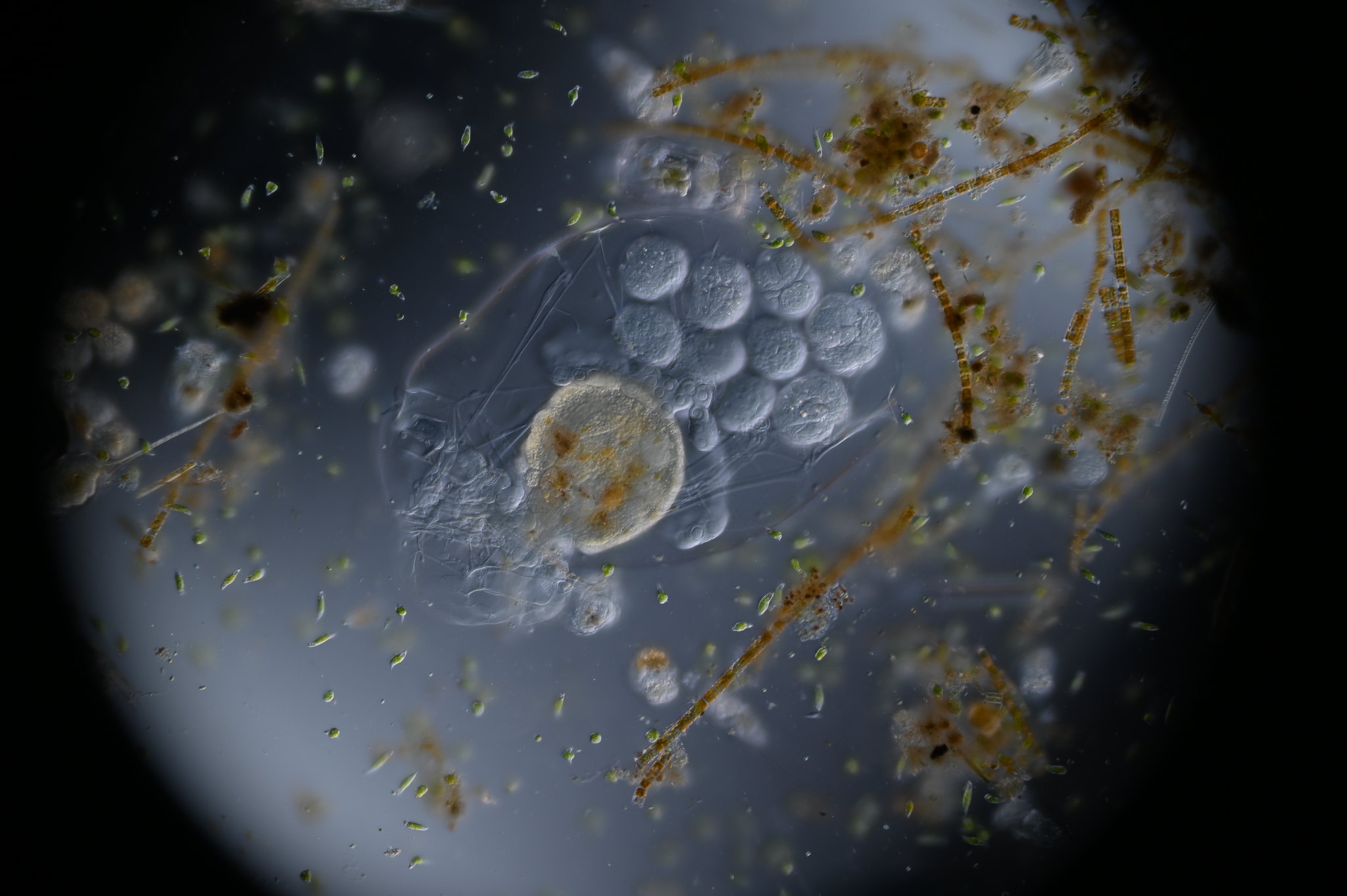Page 1 of 1
A giant rotifer in Amsterdam
Posted: Mon Mar 20, 2023 12:32 am
by MasLovesMicrobes
Another sample from the canals of Amsterdam. I have never seen such a big rotifer, I'm guessing nearly a millimeter. In Dutch we call this raderdiertje, which means little radar animal.
If anyone knows what species I'm curious. It's tremendously beautiful.
20x DIC
 ZJA_6311
ZJA_6311 by
Mas Jansma, on Flickr
The muscles and neurons
40x DIC
 ZJA_6303
ZJA_6303 by
Mas Jansma, on Flickr
The stomach and corona
 ZJA_6300
ZJA_6300 by
Mas Jansma, on Flickr
The developing eggs, various stages
60x wi DIC
 ZJA_6327
ZJA_6327 by
Mas Jansma, on Flickr
 ZJA_6327
ZJA_6327 by
Mas Jansma, on Flickr
Here you can clearly see the cell division and increasing complexity of the eggs
40x DIC
 ZJA_6305
ZJA_6305 by
Mas Jansma, on Flickr
Let me know what you think of the lighting on these. I like the softer look, but if this is too soft, or too dark, I'm curious to know.
If anyone is curious I'm using U-DICTH which is the high resolution type Olympus DIC. This has lower shear/contrast, I'm guessing this is why my images look soft.
4K resolution on my flickr page.
I'm making a little video about these rotifers, not sure when it will be done. I'm pretty busy at the moment, but hopefully soon I'll finish it.
Kind regards, Mas
Re: A giant rotifer in Amsterdam
Posted: Mon Mar 20, 2023 2:15 am
by actinophrys
This is lovely work. The rotifer is Asplanchna, a large predatory type with jaws that extend to grab prey. They are also viviparous, hence the eggs developing inside.
Re: A giant rotifer in Amsterdam
Posted: Mon Mar 20, 2023 3:14 pm
by MasLovesMicrobes
Ah thanks actinophrys.
Interesting that they display such sexual dimorphism. I'll try and see if I can recognise the male next.
Anomalous Mating. The males of A. brightwelli have been observed to mate with other males, newborn females, and with other females two and three times their own size taken from stock mictic cultures containing vitamin E. They have also mated with young females of similar size taken from amictic cultures without vitamin E. Normally, these mating have occurred between two individuals. However, occasionally, relationships such as two or three males simultaneously attached to one female, or one male copulating with one female while another male copulates with him have been observed. (ref. ID; 5088)
Amazing! They are gay! This is the first time I've thought about microbial sexual orientation. Seems they have no problems with bisexual orgies either. This is truly fantastic! Now that would make a great photo!
Re: A giant rotifer in Amsterdam
Posted: Mon Mar 20, 2023 4:42 pm
by einman
What you are describing is not unusual in nature where you have competition amongst males to spread their genetics. "Orgies" as you describe them happen between reptiles and amphibians as well. My dogs attempt to have sex with one another and they are both males. I have often wondered about that behavior. I believe the difference lies in sexual predisposition as opposed to sexual availability. If no females are present or the ratio of males to females (or vice versa) is quite high, such behavior becomes more readily apparent in nature. Just a thought as I have not really spent any time researching the topic.
Re: A giant rotifer in Amsterdam
Posted: Mon Mar 20, 2023 4:43 pm
by einman
Very nice photos by the way!
Re: A giant rotifer in Amsterdam
Posted: Mon Mar 20, 2023 6:09 pm
by MasLovesMicrobes
This theory certainly seems worthy of an experiment einman. I do wonder whether rotifers are so complex that they might develop such a thing as a sexual orientation. I too wonder about all the little dynamics and feelings that take place around sex on such a small scale. I wonder so many things, but it might be best to lend them a little privacy, and leave them their lovers.
Re: A giant rotifer in Amsterdam
Posted: Mon Mar 20, 2023 7:32 pm
by actinophrys
Sexual dimorphism is standard for monogonont rotifers like this one, where most individuals are female and can reproduce parthenogenetically, and males are small and only occur on occasion. In bdelloid rotifers there actually aren't any males at all. Usually all-female animals are isolated species and it's expected they tend to go extinct, though people aren't entirely sure why. So how bdelloids alone have done so well without sexual reproduction is still being investigated...main theories are that being able to survive drying out allows them to keep ahead of parasites either way, and that patching their genes with environmental DNA fulfills the same role.
Re: A giant rotifer in Amsterdam
Posted: Tue Mar 21, 2023 7:57 pm
by MasLovesMicrobes
How very interesting, thanks actinophrys.
Re: A giant rotifer in Amsterdam
Posted: Fri Mar 24, 2023 1:44 pm
by Javier
Very cool images and good information on this thread.
I found one of those Asplanchna Rotifers some tieme ago. The size is impressive.
 ZJA_6311 by Mas Jansma, on Flickr
ZJA_6311 by Mas Jansma, on Flickr ZJA_6303 by Mas Jansma, on Flickr
ZJA_6303 by Mas Jansma, on Flickr ZJA_6300 by Mas Jansma, on Flickr
ZJA_6300 by Mas Jansma, on Flickr ZJA_6327 by Mas Jansma, on Flickr
ZJA_6327 by Mas Jansma, on Flickr ZJA_6327 by Mas Jansma, on Flickr
ZJA_6327 by Mas Jansma, on Flickr ZJA_6305 by Mas Jansma, on Flickr
ZJA_6305 by Mas Jansma, on Flickr ZJA_6311 by Mas Jansma, on Flickr
ZJA_6311 by Mas Jansma, on Flickr ZJA_6303 by Mas Jansma, on Flickr
ZJA_6303 by Mas Jansma, on Flickr ZJA_6300 by Mas Jansma, on Flickr
ZJA_6300 by Mas Jansma, on Flickr ZJA_6327 by Mas Jansma, on Flickr
ZJA_6327 by Mas Jansma, on Flickr ZJA_6327 by Mas Jansma, on Flickr
ZJA_6327 by Mas Jansma, on Flickr ZJA_6305 by Mas Jansma, on Flickr
ZJA_6305 by Mas Jansma, on Flickr